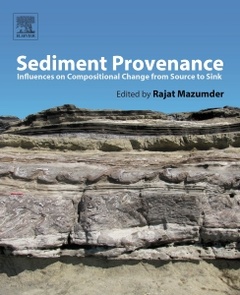Sediment Provenance Influences on Compositional Change from Source to Sink
Coordonnateur : Mazumder Rajat

Sediment Provenance: Influences on Compositional Change from Source to Sink provides a thorough and inclusive overview that features data-based case studies on a broad range of dynamic aspects in sedimentary rock structure and deposition. Provenance data plays a critical role in a number of aspects of sedimentary rocks, including the assessment of palaeogeographic reconstructions, the constraints of lateral displacements in orogens, the characterization of crust which is no longer exposed, the mapping of depositional systems, sub-surface correlation, and in predicting reservoir quality.
The provenance of fine-grained sediments?on a global scale?has been used to monitor crustal evolution, and sediment transport is paramount in considering restoration techniques for both watershed and river restoration. Transport is responsible for erosion, bank undercutting, sandbar formation, aggradation, gullying, and plugging, as well as bed form migration and generation of primary sedimentary structures.
Additionally, the quest for reservoir quality in contemporary hydrocarbon exploration and extraction necessitates a deliberate focus on diagenesis. This book addresses all of these challenges and arms geoscientists with an all-in-one reference to sedimentary rocks, from source to deposition.
Rajat Mazumder
2. Evolution of Siliciclastic Provenance Inquiries: A Critical Appraisal
Abhijit Basu
3. Tracing the source of the bio/siliciclastic beach sands at Rosa Marina (Apulian coast, SE Italy)
Tom van Loon
4. Changes in the heavy-mineral spectra on their way from various sources to joint sinks - a case study of Pleistocene sandurs and an ice-marginal valley in NW Poland
Tom van Loon
5. Reconstruction of paleohydraulic condition from depositional structures: a critical appraisal
Prabir Dasgupta
6. Physico-chemical Characteristics of the Barremian-Aptian Siliciclastic Rocks in the Pondicherry Embryonic Rift Sub-basin, India
Subir Sarkar
7. Petrological and geochemical constraints on provenance, paleo-weathering and tectonic setting of clastic sediments from the Neogene Lambir and Sibuti Formations, North West Borneo
Ramasamy Nagarajan
8. Where are the Precambrian Tsunami Deposits? Madagascar Chevrons and other Modern Analogues Provide Insights into Identifying Ancient Tsunamigenic Sequences
Dallas Abbott
9. The Contourite Problem
G. Shanmugam
10. Fluvial Systems, Provenance and Reservoir Development in the Eocene Brennan Basin Member of the Duchesne River Formation, Northern Uinta Basin, Utah
Marjorie A. Chan and Takashi Sato
11. Changes in the shape of breccia lenses during sliding from source to sink in the Cambrian epeiric sea of the North China Platform
Tom van Loon
12. Provenance of chert rudites and arenites in the northern Canadian Cordillera
Darrel Graham Francis Long
13. Late Neoproterozoic to early Mesozoic sedimentary rocks of the Tasmanides, eastern Australia: Provenance switching associated with development of the East Gondwana active margin
Chris Fergusson
14. Utility of Detrital Zircons in an Upper Amphibolite Facies Terrane
Jeffrey R. Chiarenzelli
15. Detrital zircon (U-Pb SHRIMP and LA-ICPMS) geochronology, Nd isotope mapping and sediment geochemistry from the Singhora Group, central India: Implications towards provenance, its shift and regional stratigraphic correlation
Partha Chakraborty and Kaushik Das
16. Deciphering sedimentary provenance, timing of sedimentation and metamorphism from a suite of metapelites from the Chotanagpur Granite Gneiss Complex (CGGC), India: Implications for Proterozoic tectonics in the east-central part of the Indian shield
Pulak Sengupta
17. SEM –CL fabric analysis of quartz framework population from the Mesoarchean Keonjhar Quartzite from Singhbhum Craton, eastern India – Implications for the understanding of upper continental crust
Joydip Mukhopadhyay
18. Provenance of detrital pyrite in Archaean sedimentary rocks
Giuliana Costa and Axel Hofmann
19. Ice ages in Earth history: puzzling palaeolatitudes and regional provenance of ice sheets on an evolving planet
Grant Young
20. The Isua supracrustal belt (Greenland): Spotlight on the oldest well-preserved sedimentary systems (~3.7, ~3.75 and ~3.8 Ga)
Allen Nutman
- Provides the latest data available on various aspects of sedimentary rocks from their source to deposition
- Features case studies throughout that illustrate new data and critical analyses of published data by some of the world’s most pre-eminent sedimentologists
- Includes more than 150 illustrations, photos, figures, and diagrams that underscore key concepts
Date de parution : 10-2016
Ouvrage de 614 p.
19x23.3 cm
Thème de Sediment Provenance :
Mots-clés :
Chemical composition; Detrital zircon geochronology; Modal analysis; Plate tectonic provenance; Sandstone; Adriatic coast; Beach sand; Grain-size analysis; Rosa Marina; Source-area reconstruction; Flow regime; Grain sorting; Heavy minerals; Paleogeographical reconstruction; Poland; Sediment transport; Weichselian; Antidune; Bed form stability; Critical grain size; Cross-stratification; Dune; Entrainment; Flume experiment; Froude number; Hysteresis; Paleohydraulic reconstruction; Ripple; Barremian-Aptian; Physical background; Provenance; Rift-embryonic siliciclastic sediments; Sediment geochemistry; Tectonic setting and climate; Geochemistry; Lambir formation; Miocene sediments; Northern borneo; Contourites; Cyclones; Gulf of Cadiz; Internal wave/tide-driven baroclinic currents; Mediterranean Outflow Water; Thermohaline-driven geostrophic contour currents; Tide-driven bottom currents; Tsunamis; Wind-driven bottom currents; Fluvial; QEMScan; Sandstone reservoir; Source-to-sink; Uinta Basin; Uinta Mountains; Breccia lenses; Chaomidian formation; Epeiric sea; North China Platform; Reshaping; Sliding; Chert; Cretaceous; Piggyback basins; Tectonics; Yukon; Zircon geochronology; Australia; Delamerian Orogen; Detrital zircon ages; East Gondwana; Lachlan Orogen; Mossman Orogen; New England Orogen; Tasmanides; Thomson Orogen; Adirondack Lowlands; Basin evolution; Detrital zircons; Grenville Province; Grenville Supergroup; Upper amphibolite facies; Detrital zircon (U-Pb) ages; Interbasinal correlation; Nd-isotope mapping; Provenance shift; Singhora basin; CGGC; Columbia supercontinent breakup; Metamorphism; Paleoproterozoic sedimentation; U-Pb zircon; Arenite; Continental crust; Mesoarchean; Petrography; SEM-CL; Singhbhum craton; Archean; Conglomerate; Detrital pyrite; Gold; Paleoplacer deposits; Witwatersrand basin; Arc volcanic sediments; Banded iron formation; Dolostones; Early atmosphere; Eoarchean; Isua; Marine transgression; Unconformity; Weathering


